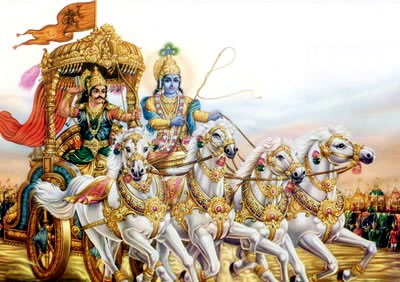 |
| Bhagavad Gita |
The Bhagavad Gita is regarded as one of the most beautiful and influential of Hindu poems. The translation from Sanskrit is the “Song of God.” It forms part of chapter 6 of the Mahabharata (epic of the Bharata dynasty).
It was probably written in the first–second century c.e., which is later than that of the remainder of the Mahabharata and has an unknown author or authors. It consists of 18 verse chapters with a total of 700 verses in the Sanskrit language, each of which consists of 32 syllables.
As part of one of the great epics of Indian thought expressed in the Sanskrit language (together with the Ramayana), the Bhagavad Gita has gone on to inspire a large number of adaptations to contemporaneous settings in both oral and written forms. Its characters have become deeply loved by millions, many of whom consider them to be exemplars for everyday action.
  |
The subject matter of the Bhagavad Gita is a lengthy conversation between Prince Arjuna, an important figure in the Mahabharata, and Krishna, who is his charioteer and also the incarnation of the god Vishnu on Earth. Krishna uses the opportunity to expound on many important theological topics for the education of both Arjuna and the audience.
The exposition is centered on, but not limited to, the concept of duty and the role that humankind is expected to play in the world. Arjuna, at the moment when the dialogue begins, is standing in the ranks of soldiers about to stage the crucial battle between the Pandavas and the Kauravas.
He is unsure whether the forthcoming carnage is worthwhile and whether he should throw down his weapons and surrender himself to fate. Krishna advises him that it is appropriate for man to take part in a virtuous enterprise being mindful of God and without seeking earthly rewards or power as the price for participation.
The lesson expands into the ways in which humanity can know and understand God. The Hindu concept of mystic union with God is presented as a threefold approach to transcendence, through merging with the immanent spirit of the universe, through understanding God as the ultimate state of nature, and through the transcendence of the human spirit.
The physical world, in which Krishna is addressing Arjuna, and Arjuna’s interaction with the universe are both real and also a reflection of the spiritual realm in which he is expected to undertake his duties.
Lord Krishna speaks of the variety of Yogas, which are the forms of unity between self and the universe that are the true goal of the individual. The role of the individual is to become closer to union with the universe through yogic practices and meditation.
Many cogent commentaries on the work have added to the significance of the Bhagavad Gita. One of the most well known is that provided by Mohandas Gandhi, who provided a series of talks to followers over a period of some months in 1926. He used the poem to enthuse his audience with the delights and fulfillment to be found in the true performance of duty.
Many Western scholars and academics have also found inspiration in the work, including Carl Jung, Ralph Waldo Emerson, Aldous Huxley, and Hermann Hesse. It continues to have an important inspirational influence on believers in yogic faiths and for those who wish to continue the Indian tradition of argumentative discourse in the search for truth.